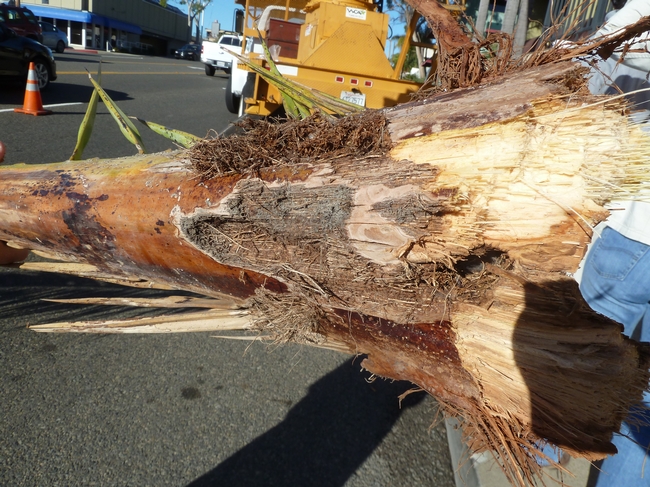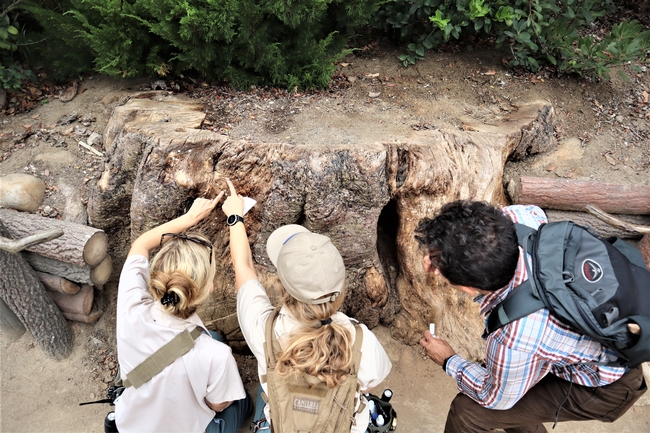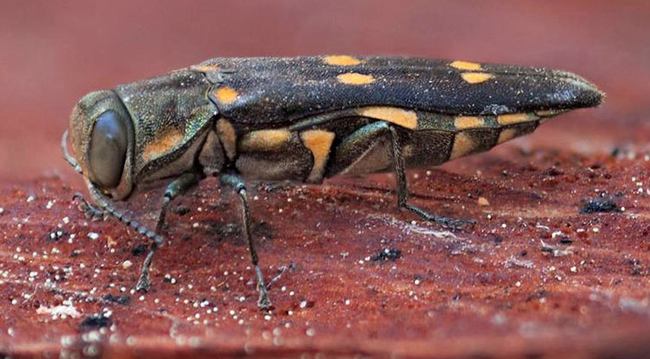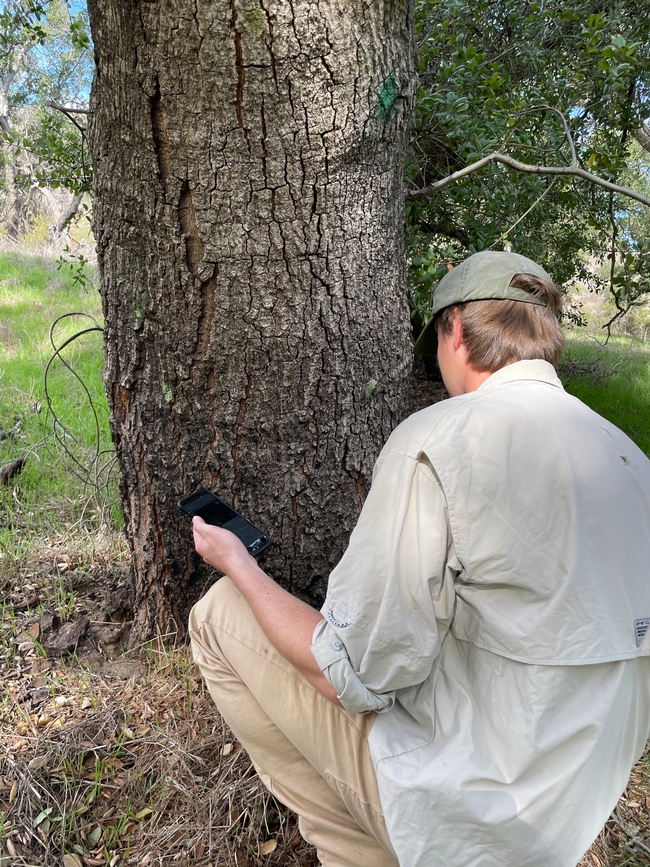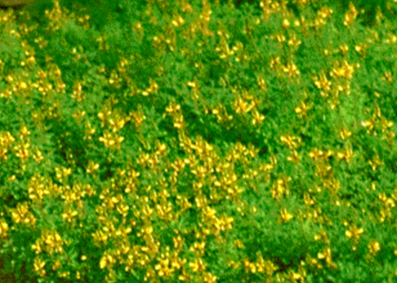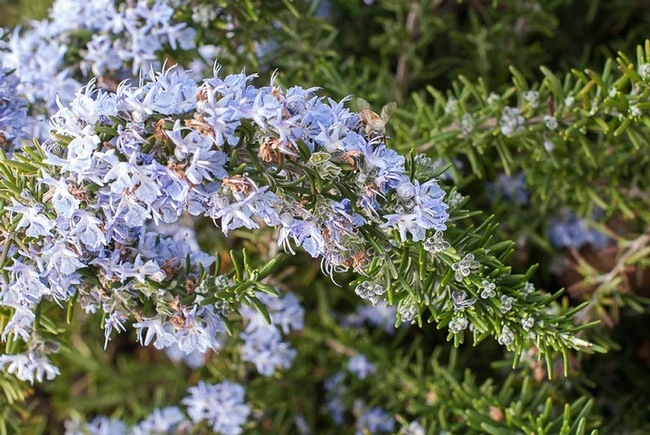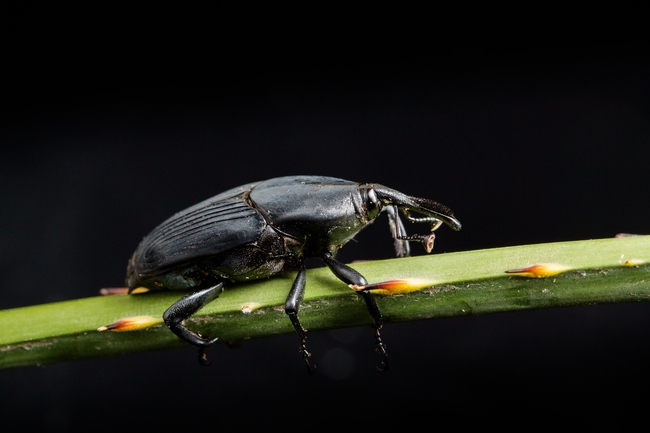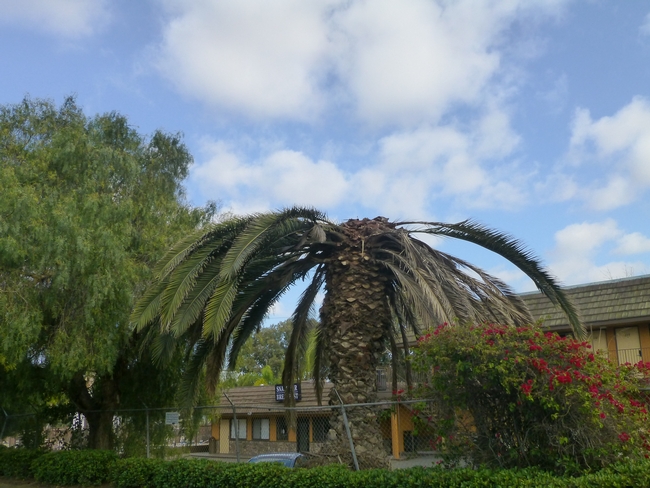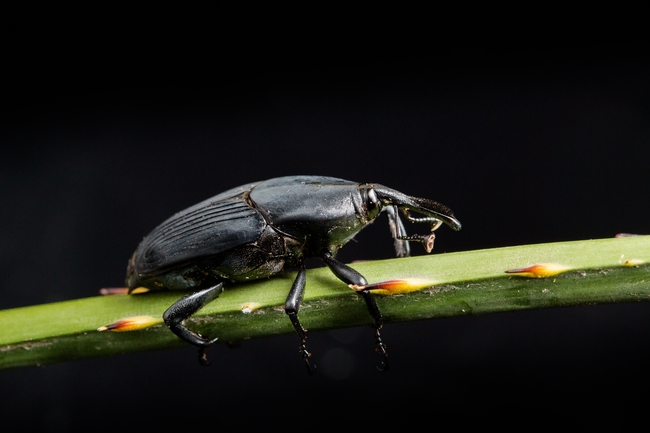
Posts Tagged: palm
Invasive pests kill thousands of trees, but scientists see some successes
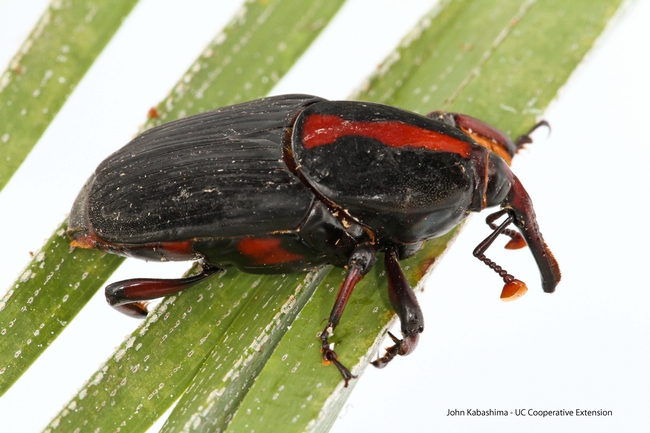
Early detection increases the chances of eradicating pests
Trees provide shade to keep us cool, produce oxygen for us to breathe and calm our nerves. Numerous studies have demonstrated that even brief contact with trees and green spaces can provide significant human health benefits such as reductions in blood pressure and stress-related hormones. Trees also reduce noise and visual pollution, help manage storm water runoff, reduce erosion and provide habitat for birds and wildlife. Trees naturally capture carbon, helping to offset the forces of climate change. They also increase the value of our properties and communities. In short, trees are essential to our well-being.
Unfortunately, invasive pests pose an ongoing threat to California's forests in both urban and wildland settings. Invasive insects such as goldspotted oak borer and invasive shothole borers have killed hundreds of thousands of trees in Southern California and are continuing to spread. Meanwhile, other pests and diseases such as Mediterranean oak borer and sudden oak death are killing trees in Northern California.
While the situation may sound dire, it is not hopeless. Of course, the best way to stop invasive pests is to prevent them from entering the state, as the California Department of Food and Agriculture has done on many occasions. For example, several months ago, CDFA border inspectors seized a load of firewood containing spotted lanternfly eggs (a pest that is causing extensive damage on the East Coast). When pests do sneak in, the next defense is to catch them early before they become established. Finally, even if pests do become established, they can be managed if not completely eradicated.
A few examples may help to illustrate why invasive tree pests deserve action, but not panic.
Red striped palm weevil eradicated in Laguna Beach
When red striped palm weevil, a highly destructive palm pest native to Indonesia, was discovered in Laguna Beach in October 2010, a working group was quickly formed to develop a management plan. The small but diverse group included international palm weevil experts, research scientists from University of California Riverside, CDFA and U.S. Department of Agriculture, UC Cooperative Extension personnel from San Diego, Orange and Los Angeles counties and county entomologists from the agricultural commissioner's offices in Orange and San Diego counties.
The resulting response included a pheromone-based trapping program, public advisory and targeted insecticide treatments. Within two years, additional trapping and inspections could not find any signs of continued infestations. Early detection was key to the success: the infestation in Laguna Beach was identified early, so the weevil population was still relatively small. In addition, Laguna Beach is geographically isolated, the local climate is much cooler than the weevil's place of origin, and the eradication effort was well funded by state and federal agencies. Eliminating invasive pests where such conditions are not present may prove more difficult.
Invasive shothole borers attack Disneyland
The Disneyland Resort in Anaheim contains 16,000 trees and over 680 different tree species. When park officials identified an infestation by invasive shothole borers in 2016, their initial attempts at vanquishing the insects with pesticides produced mixed results. Then, they consulted with experts from UC Riverside and UC Cooperative Extension and together designed and followed an integrated pest management program that included monthly ground surveys, a trapping program that helped to detect infestation hot spots and find and remove the source of beetles, and occasional pesticide treatments on selected trees. The park went from a large number of beetles in 2017 to very low levels today. There are still some beetles, but resulting damage is extremely low, and although monitoring programs continue, the park's landscape team has been able to turn its focus elsewhere.
Goldspotted oak borer spotted in Weir Canyon
When goldspotted oak borer was confirmed in Orange County's Weir Canyon in 2014, a team from Irvine Ranch Conservancy, the organization that manages the area on behalf of Orange County Parks, sprang into action. UC Cooperative Extension and the US Forest Service assisted IRC in developing a management program, and over the ensuing years, IRC has actively collaborated with OC Parks, The Nature Conservancy, OC Fire Authority, and CAL FIRE to control the existing infestation and stop its spread. IRC has surveyed the oaks in the area yearly to monitor the infestation and guide each year's management actions.
To reduce the spread of the infestation, IRC removed more than 100 severely infested oaks in the first few years of management (no severely infested oaks have been found in the last few years of surveys). Additionally, more than 3,000 tree trunks have been sprayed annually in the late spring to kill emerging adult beetles and newly hatched offspring.
In the most recent survey of the oaks in Weir Canyon, the IRC team found only 12 trees with new exit holes, and most of those had just one to two exit holes per tree, which is an extremely low number. With the situation well under control, IRC is now considering modifying its annual spraying program and adapting other less aggressive treatment options. Finally, IRC has been actively planting acorns to mitigate losses due to the removals as well as the Canyon 2 Fire of 2016.
As these brief examples demonstrate, insect pest infestations can be managed or even eradicated if caught early enough. Early detection not only increases the chances of success, but also minimizes the cost of pest management efforts.
What you can do to prevent infestation
While management actions will vary depending on the insect or disease, species of tree and location, there are a few steps that will lead to greater success in fighting tree pests and diseases.
- Keep your trees healthy. Proper irrigation and maintenance go a long way toward keeping trees strong and resistant to pests and diseases.
- Check your trees early and often for signs and symptoms of tree pests and diseases. These may include entry/exit holes, staining, gumming, sugary build-ups, sawdust-like excretions, and branch or canopy dieback. Use available tools like the UC IPM website to determine probable causes of the problems.
- Talk with experts (arborists, pest control advisers, researchers and advisors from the University of California and other institutions), and report pest findings to your county Agricultural Commissioner.
- Evaluate the extent of tree damage and determine a management plan. Remove severely infested branches and trees that may be a source of insect pests that can attack other trees.
- Properly manage infested wood and green waste. Chip wood and other plant materials as small as possible. Solarization or composting can further increase the effectiveness of chipping. It is generally best to keep those materials close to where they originated, but if you absolutely need to move them, first make sure the facility where they will be sent is equipped to process them. Always tightly cover materials while in transit. If working with a tree care professional, insist that proper disposal is part of the job requirements.
- Many invasive tree pests can survive in down wood for long periods. When buying or collecting firewood, always obtain it as close as possible to where you are going to burn it and leave leftover firewood in place.
Synthetic turf, dark mulch and asphalt surfaces are superheating our inland cities
an plants help cool our urban heat islands and mitigate impacts of climate change in our inland cities? I've been interested in measuring the temperatures of living and non-living surfaces for some time. Preliminary results are in! Use of dark asphalt, synthetic turf,
What can you do?
Take care of your trees, shrubs, groundcovers, and lawns to maximize their ability to cool the surrounding environment. In the same experiment described above, the coolest temperatures occurred in lawns growing in the shade of a mature tree. This is due to living plants cooling the environment during the process of transpiration. Non-living surfaces don't provide this natural air-conditioning. While many people believe lawns waste water, it's important to fully consider the alternative of replacing a water-efficient warm-season lawn like Bermuda or Buffalograss with either dark mulch or no living plants at all. The lawns are much cooler! Our previous UC studies determined that it's often not the lawns (and other sprinkler-irrigated plants like groundcovers) that waste the water, it's the uneven coverage (low distribution uniformity) of most sprinkler systems, coupled with not applying the right amount of water seasonally.
However, If you're tired of your high maintenance lawn and want to ditch your lawnmower, fertilizers, and pesticides, consider a low-maintenance drought-resistant groundcover that has similar cooling effects without the need for chemical inputs.
Plant drought-tolerant groundcovers
Here are just a few examples:
Peruvian Verbena (Verbena peruviana). This groundcover grows to only 1" tall and sports dark green leaves and white to pinkish (several hybrids available) blossoms that bloom from spring through fall. It spreads quickly and requires little water once established.
Dwarf Rosemary (Rosmarinus prostratus) This particular rosemary species is a low-growing groundcover. It is a great choice for rock gardens, reaching only 6 inches tall. It produces purple flowers in the summer and attracts pollinators and can be used for culinary purposes (bottom).
Gold Dalea (Dalea capitata). This semi-deciduous evergreen grows between 8" to 1' tall and has small yellow flowers that bloom in spring and fall and a pleasant scent. It is very heat tolerant and great for urban heat islands (parking lots, etc.) as well as planters and paths (lower right).
For more information on trees, groundcovers, shrubs, and vines suitable for your own home, contact a UC Cooperative Extension Master Gardener volunteer in your county using this link: https://mg.ucanr.edu/FindUs/
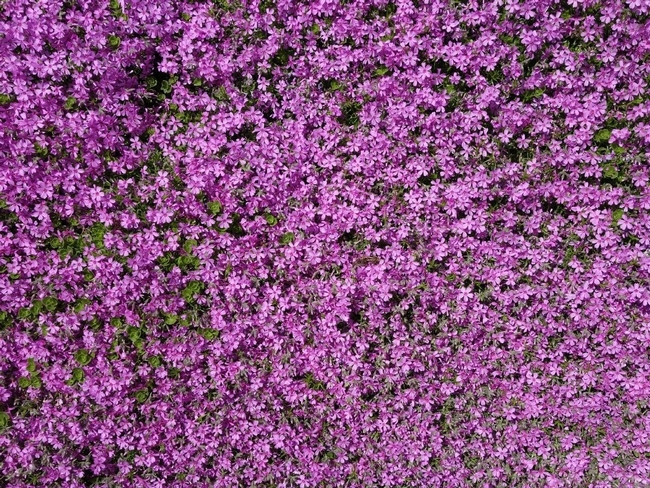
Keep Your Palm Trees Disease-free
Palm trees are commonly seen in California, making some think about the tree-lined streets of...

D-WO-FOXY-FO.010
South America palm weevil is killing palm trees in Southern California
South American palm weevils that have made their way north from Mexico are having a destructive impact on palm trees in the San Diego region, reported Abbie Alford on CBS News 8 TV in San Diego.
UC Cooperative Extension specialist Mark Hoddle, the director of the Center for Invasive Species Research at UC Riverside, toured the reporter through the hard-hit Sweetwater Reserve in Bonita, where 10 percent of the palms die every three months.
“We are going to see hundreds, thousands of Canary Island Date Palms die over the next couple of years,” he said.
The weevils use their protruding noses to drill holes in the palm, where females lay their eggs.
San Diego County Agriculture, Weights and Measurements said it plans to remove 50 infested Canary Island Palms from the Sweetwater Regional Park and is educating arborists about the invasive pest.
A spokesperson for the City of San Diego said it is working with UC Cooperative Extension.
South American palm weevil stars in a Hollywood horror film
One of Los Angeles' quintessential icons - palm trees - are being threatened by an invasive pest from overseas - the South American palm weevil. KQED Science produced a clever overview on the life and times of this devastating pest, punctuating it with a surprise ending that features UC Cooperative Extension specialist Mark Hoddle.
The story outlines the pest's life cycle, which starts when a female lays its eggs in the crown of a palm. They hatch and larvae eat the plant from the inside out, eventually killing the palm. The larvae pupate, complete metamorphosis, then fly off to find another palm to attack.
Hoddle conducted an experiment to determine how far the weevils can fly. He glued the pest on a sort of insect treadmill and let it fly in circles. He found that they can travel up to 15 miles a day, enough to easily hopscotch from palm to palm on their own and spread widely.
The biocontrol scientist demonstrates one way to get rid of South American palm weevils. If you're not squeamish you can view the video on the KQED website.

